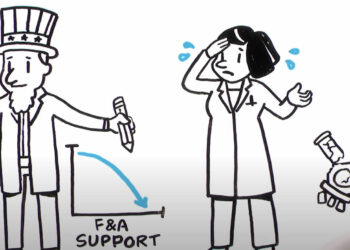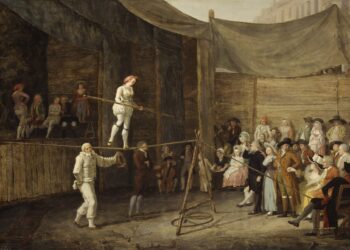
Every Christmas Santa never fails to slide down the chimney with a crystal ball. This year was no exception, and the nifty forecasting tool came with a wonderful stocking stuffer, a set of links from Gary Price of Infodocket. If you don’t know Gary, I recommend that you follow him on Twitter: @infodocket. It’s like having your own personal librarian.
The links this year are to two announcements from Elsevier, one on a number of journals Elsevier is “flipping” to Open Access (OA) (including publications that are part of the SCOAP initiative). The other is for a new OA journal. So we have Elsevier, everybody’s Grinch, getting more deeply involved with OA publishing even as the company continues to lobby hard for its own interests and issues takedown notices to authors who have posted copies of their articles on the Web without Elsevier’s approval. What is going on here?
I was pondering this when I happened to look again at a lengthy presentation on scholarly communications and OA, which I would characterize as the lump of coal in someone’s Christmas stocking. I first stumbled on this presentation when it was recommended to me on a social media site, and I opened it up eagerly. Alas, it is very disappointing. Fifteen years ago it might have seemed like an interesting piece of work, but now? For example, it includes the wholly original insight that publishers are in business to make money and that libraries don’t have enough money to acquire everything they want for their collections. The solution? Open Access, of course, which solves all problems.
Here’s the problem: When we look at the landscape of scholarly communications today, what do we see? The presentation cited above contrasts Then (an old print volume) and Now, which is a combination of the predatory practices of commercial firms and the glorious world of OA and liberation from those very same big commercial outfits. The subtitle sums up the flavor nicely: Which Side Are You On? For people with their eyes open, however, there is so much going on in scholarly communications, with the commercial organizations right at the center of it, that a glib division of the landscape into good guys and bad, OA devotees and old-fashioned publishers, really seems like a case of hardening of the categories.
The fact is that Elsevier, Springer, Wiley, Sage, and so on are now all significant OA publishers, so a Then-and-Now game mischaracterizes things and could lead to unwise actions. OA is simply no longer a revolutionary challenge to the powers that be. It is being domesticated and monetized by established commercial firms even as talented upstarts like PLoS continue to thrive.
If OA is not overturning the publishing paradigm, or at least the organizations that stood atop the traditional paradigm, what then should we expect the world to look like in a few years? We wave our hands over the crystal ball, chant a magical invocation–
–and we come up with the following:
Ongoing increase in the number of OA publications, coming from both the not-for-profit and the for-profit sectors. I don’t think we will see the likes of another PLoS; the Internet favors singularities: one Amazon, one Facebook, one not-for-profit megajournal. But we will see oodles of branded OA services, some conceived as extensions of existing traditional publications.
Ongoing dominance of the library sector by a small number of major publishers. This was the business that was supposed to go away, but if anything the largest publishers are tightening their grip on library budgets. As long as libraries have budgets for materials, a small number of companies will gobble up most of that money.
As a consequence of the point above, smaller publishers will either merge or align with the major publishers or flip to a Gold OA model, becoming, as it were, mini-PLoS’s, but working in narrow disciplines with the support of the pre-existing brand. Few small publishers will disappear, as there are many reasons for the largest publishers to add them to their portfolio.
New publications and services will continue to be brought into the marketplace, with the focus on OA and discovery tools. The reason for new journals to be OA is simply that the path of a new toll-access journal is blocked by the incumbents. If there is wide-open space it is in the area of discovery in the OA sector. Traditional journals have a built-in discovery tool, the journal’s brand, but the OA universe must evolve a suite of post-publication services for discovery and assessment. The traditional publishers don’t have any obvious advantage in this area because the new services will be mostly marketed to individuals, not to libraries, which is where the established publishers derive most of their strength.
In the competition for author submissions, there will be increasing pressure to lower or drop page charges. For small publishers this can be a significant problem, as page charges make up a major source of revenue. This in turn will lead more small publishers to seek the embrace of a large partner.
The rebirth of the book arises from the new digital technologies, including mobile platforms. Many publishers of scholarly material that closed down or sold off their book programs years ago will eye the new opportunity of app-based ebooks and the many vendors springing up to provide the tools. The new platforms sidestep the curse of the print book business, the amount of capital tied up in inventory, by being e-only or with print simply as an on-demand option; and the evolving tool set enables specialized publishers to play down or forego sales through the intimidating Amazon. A corollary to this is the creation of a great many more online bookstores, some topic-specific, some a storefront on the publisher’s own Web site.
I had a drink with the reindeer and listened in on a conversation about page charges. It was pointed out that there are two kinds of charges: old-fashioned page charges that came about many years ago to offset the high cost of production, and OA fees for hybrid publications. With PLoS ONE charging $1,350 for Gold OA publication, many authors balk at the idea of first paying a thousand dollars or more for page charges and then being asked for an additional sum to make an article OA. Will the page charges inevitably go away or merge with the OA fees? This would lead to more and more traditional journals becoming hybrids: OA on an article-by-article basis for readers, but toll-based on a comprehensive basis for libraries.
The hybrid journal represents something of a delicious irony in that it enables established publishers to use their brands to move them into OA publishing even as it opens up an additive revenue stream. This practice is often derided as “double-dipping,” but for the publisher that successfully implements it, it is a very merry Christmas and a happy new year.
Discussion
17 Thoughts on "Publishing Viewed from Santa's Crystal Ball"
Joe, One wonders if the move to Open Access by large publishers like Elsevier is a way for them to gracefully embrace OA with journals that may no longer be profitable to publish as subscriptions. Moving to a Gold OA publishing model might hide the financial dynamics for a scholarly peer reviewed journal that is not doing well or meeting their profit hurdles as a subscription and potentially make it profitable through the APC payments.
One would think that a journal that cannot attract subscriptions would not then attract paying authors. An interesting exception might be emerging fields, where the research is ahead of the library lag time.
That does seem like a reasonable assumption, but experience doesn’t bear it out. There are lots of tenure-track faculty out there whose careers will be helped by publication in even marginal journals. That’s why journal publishers like many of the ones on Beall’s List (not to mention certain monograph publishers who shall not be named) are able to make money by selling authors what amounts to vanity publishing.
The big unanswered question lies in how funding for OA will come about. In the sciences major foundations like the Wellcome Trust have stepped forward to help change the landscape. there is no comparable institutional source of funding outside of academe itself for publishing in the humanities. Who will pay Gold OA charges for such fields, and out of what budgets, within universities, will such fees come? There is no evident pattern yet for such funding developing across all universities. There are a few consortia, such as CORE, but often libraries are looked to for providing such funds out of their already strained budgets. So whether the transition to Gold OA succeeds in generating levels of income comparable to what TA publishing provided to publishers is yet to be determined.
My institution uses Green OA as an excuse not to fund Gold OA. That is, why pay to publish when you can post in repository for free (assuming the publisher allows this, which in the Continental Europe’s framework, where Green OA friendly publishers dominates, it’s the norm)? It’s a good point, but it slows down the seemingly inevitable (or at least probable) transition to Gold OA.
One of the things that I think really muddies the water of the OA conversation is the constant insistence on the part of its advocacy community that a “transition” to OA is “inevitable” — and, in the case of many statements, not just inevitable but imminent. While I suspect this is useful as a rhetorical device for advocacy, I think the degree to which it accurately reflects reality depends on what one means by “OA” and by “transition.” I doubt that any rational observer expects Green OA with no embargoes to be the universal reality anytime soon. Green OA with embargoes is more likely sooner, but not everyone will agree that this constitutes real OA–and don’t even get the community started on the issue of copyright and CC licensing. Gold OA is being taken up by both for-profit and not-for-profit publishers with some degree of enthusiasm, but it’s hard to see that a universal transition to Gold is likely in the foreseeable future either. What seems clear to me (rightly or wrongly) is that as time goes on there will be more and more OA, that the kinds and flavors of OA will continue to vary, and that its uptake will be spotty–both between publishers and even within them (with hybrid journals continuing to flourish). Then again, maybe I’m insufficiently visionary.
The political OA movement is not likely to be mollified by tokens, but if this trend continues it may well blunt the thrust. It would be hard to make the case for mandates when most journals offer immediate access for a price.
You note that “The hybrid journal represents something of a delicious irony in that it enables established publishers to use their brands to move them into OA publishing even as it opens up an additive revenue stream. This practice is often derided as “double-dipping,” but for the publisher that successfully implements it, it is a very merry Christmas and a happy new year.”
How is this a good thing for libraries and the researchers who use libraries? Are you in favor of publishers who double-dip?
I think that passage is pretty self-evident. The author points out the irony in that what’s supposed to be something that will provide financial relief is being used by some to instead drive further gain, and those that do so are likely enjoying those rewards. I see no statement of approval of this practice. We can ask Joe to be less subtle in the future.
There is no such thing as double-dipping. So how can I be in favor of it or opposed to it? I really think some people in the OA community should leave their moral categories at home. I was describing something; I was not advocating anything. The speed of light is 186,000 miles per second: Are you for it or against it?
It’s not just the OA community. At least some major publishers are arguing pretty hard they are not doing something that doesn’t exist.
I think it is telling when less than 1% of Elsevier’s authors are willing to pay a hybrid fee and industry wide its maybe 2%. I guess you can say there is no double dipping when virtually no authors are taking up the option at the typical 3,000 USD price.
Ok., so David Crotty says that double-dipping “is being used by some to instead drive further gain, and those that do so are likely enjoying those rewards” and you (Joseph E.) says that there is no such thing. I am guessing that there might be some publishers who take advantage of this opportunity. The problem is that not all publishers reveal all of their financial information. There is no way for librarians to know that there is no such thing as double-dipping.
Sorry, but I thought you were for the practice of double-dipping by saying “for the publisher that successfully implements” a double-dipping system, that they would have a better financial statement at the end of the year. My apologies.
The confusion may stem from how one defines “double-dipping”. Some have argued that this merely represents the nature of the business, that journals (even fully OA journals) rely on multiple revenue streams:
http://scholarlykitchen.sspnet.org/2013/01/29/in-praise-of-double-dipping-fairness-affordability-vitality-and-sustainability/



